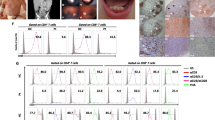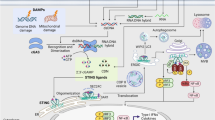Abstract
Transglutaminase 2 (TG2) has been known for a long time to be associated with the in vivo apoptosis program of various cell types, including T cells. Though the expression of the enzyme is strongly induced in mouse thymocytes following apoptosis induction in vivo, no significant induction of TG2 can be detected, when thymocytes are induced to die by the same stimuli in vitro indicating that signals arriving from the tissue environment are required for the proper in vivo induction of the enzyme. Previous studies from our laboratory have demonstrated that two of these signals, transforming growth factor-β (TGF-β) and retinoids, are produced by macrophages engulfing apoptotic cells. However, in addition to TGF-β and retinoids, engulfing macrophages produce adenosine as well. Here, we show that in vitro adenosine, adenosine, and retinoic acid or adenosine, TGF-β and retinoic acids together can significantly enhance the TG2 mRNA expression in dying thymocytes. The effect of adenosine is mediated via adenosine A2A receptors (A2ARs) and the A2AR-triggered adenylate cyclase signaling pathway. In accordance, loss of A2ARs in A2AR null mice significantly attenuates the in vivo induction of TG2 following apoptosis induction in the thymus indicating that adenosine indeed contributes in vivo to the apoptosis-related appearance of the enzyme. We also demonstrate that adenosine is produced extracellularly during engulfment of apoptotic thymocytes, partly from adenine nucleotides released via thymocyte pannexin-1 channels. Our data reveal a novel crosstalk between macrophages and apoptotic cells, in which apoptotic cell uptake-related adenosine production contributes to the appearance of TG2 in the dying thymocytes.





Similar content being viewed by others
Abbreviations
- A2AR:
-
Adenosine A2A receptor
- A3R:
-
Adenosine A3 receptor
- 9cRA:
-
9-cis retinoic acid
- IL:
-
Interleukin
- KC:
-
Cytokine-induced neutrophil-attracting chemokine
- NECA:
-
5′-N-ethylcarboxamidoadenosine
- MADP:
-
α,β-Methylene adenosine-5′-diphosphate
- MIP:
-
Macrophage inflammatory protein
- TG2:
-
Transglutaminase 2
- TGF-β:
-
Transforming growth factor-β
References
Amendola A, Gougeon ML, Poccia F, Bondurand A, Fesus L, Piacentini M (1996) Induction of “tissue” transglutaminase in HIV pathogenesis: evidence for high rate of apoptosis of CD4+ T lymphocytes and accessory cells in lymphoid tissues. Proc Natl Acad Sci USA 93:11057–11062
Antonioli L, Pacher P, Vizi ES, Haskó G (2013) CD39 and CD73 in immunity and inflammation. Trends Mol Med 19:355–367
Biancheri P, Giuffrida P, Docena GH, MacDonald TT, Corazza GR, Di Sabatino A (2014) The role of transforming growth factor (TGF)-β in modulating the immune response and fibrogenesis in the gut. Cytokine Growth Factor Rev 25:45–55
Chekeni FB, Elliott MR, Sandilos JK, Walk SF, Kinchen JM, Lazarowski ER, Armstrong AJ, Penuela S, Laird DW, Salvesen GS, Isakson BE, Bayliss DA, Ravichandran KS (2010) Pannexin-1 channels mediate ‘find-me’ signal release and membrane permeability during apoptosis. Nature 467:863–867
Cohen HB, Briggs KT, Marino MJP, Ravid K, Robson SC, Mosser DM (2013) TLR stimulation initiates a CD39-based autoregulatory mechanism that limits macrophage inflammatory responses. Blood 122:1935–1945
Csóka B, Németh ZH, Virág L, Gergely P, Leibovich SJ, Pacher P, Sun CX, Blackburn MR, Vizi ES, Deitch EA, Haskó G (2007) A2A adenosine receptors and C/EBPbeta are crucially required for IL-10 production by macrophages exposed to Escherichia coli. Blood 110:2685–2695
Csóka B, Himer L, Selmeczy Z, Vizi ES, Pacher P, Ledent C, Deitch EA, Spolarics Z, Németh ZH, Haskó G (2008) Adenosine A2A receptor activation inhibits T helper 1 and T helper 2 cell development and effector function. FASEB J 22:3491–3499
Csóka B, Selmeczy Z, Koscsó B, Németh ZH, Pacher P, Murray PJ, Kepka-Lenhart D, Morris SM Jr, Gause WC, Leibovich SJ, Haskó G (2012) Adenosine promotes alternative macrophage activation via A2A and A2B receptors. FASEB J 26:376–386
Eichin D, Laurila JP, Jalkanen S, Salmi M (2015) CD73 activity is dispensable for the polarization of M2 macrophages. PLoS One 10:e0134721
Elliott MR, Chekeni FB, Trampont PC, Lazarowski ER, Kadl A, Walk SF, Park D, Woodson RI, Ostankovich M, Sharma P, Lysiak JJ, Harden TK, Leitinger N, Ravichandran KS (2009) Nucleotides released by apoptotic cells act as a find-me signal to promote phagocytic clearance. Nature 46:282–286
Fabbi M, Marimpietri D, Martini S, Brancolini C, Amoresano A, Scaloni A, Bargellesi A, Cosulich E (1999) Tissue transglutaminase is a caspase substrate during apoptosis. Cleavage causes loss of transamidating function and is a biochemical marker of caspase 3 activation. Cell Death Differ 6:992–1001
Fadok VA, Bratton DL, Konowal A, Freed PW, Westcott JY, Henson PM (1998) Macrophages that have ingested apoptotic cells in vitro inhibit proinflammatory cytokine production through autocrine/paracrine mechanisms involving TGF-beta, PGE2, and PAF. J Clin Invest 101:890–898
Fésüs L, Piacentini M (2002) Transglutaminase 2: an enigmatic enzyme with diverse functions. Trends Biochem Sci 27:534–539
Fésüs L, Szondy Z (2005) Transglutaminase 2 in the balance of cell death and survival. FEBS Lett 579:3297–3302
Folk JE, Chung SI (1985) Transglutaminases. Methods Enzymol 113:358–375
Fonseca PC, Nihei OK, Urban-Maldonado M, Abreu S, de Carvalho AC, Spray DC, Savino W, Alves LA (2004) Characterization of connexin 30.3 and 43 in thymocytes. Immunol Lett 94:65–75
Fredholm BB (2001) International union of pharmacology. XXV. Nomenclature and classification of adenosine receptors. Pharmacol Rev 53:527–552
Garabuczi É, Kiss B, Felszeghy S, Tsay GJ, Fésüs L, Szondy Z (2013) Retinoids produced by macrophages engulfing apoptotic cells contribute to the appearance of transglutaminase 2 in apoptotic thymocytes. Amino Acids 44:235–244
Haskó G, Cronstein BN (2004) Adenosine: an endogenous regulator of innate immunity. Trends Immunol 25:33–39
Haskó G, Szabó C, Németh ZH, Kvetan V, Pastores SM, Vizi E (1996) Adenosine receptor agonists differentially regulate IL-10, TNF-alpha, and nitric oxide production in RAW 264.7 macrophages and in endotoxemic mice. J Immunol 157:4634–4640
Heine P et al (2001) The C-terminal cysteine-rich region dictates specific catalytic properties in chimeras of the ectonucleotidases NTPDase1 and NTPDase2. Eur J Biochem 268:364–373
Kiss I, Oskolás H, Tóth R, Bouillet P, Tóth K, Fülöp A, Scholtz B, Ledent C, Fésüs L, Szondy Z (2006) Adenosine A2A receptor-mediated cell death of mouse thymocytes involves adenylate cyclase and Bim and is negatively regulated by Nur77. Eur J Immunol 36:1559–1571
Konkel JE, Jin W, Abbatiello B, Grainger JR, Chen W (2014) Thymocyte apoptosis drives the intrathymic generation of regulatory T cells. Proc Natl Acad Sci USA 111:E465–E473
Köröskényi K, Duró E, Pallai A, Sarang Z, Kloor D, Ucker DS, Beceiro S, Castrillo A, Chawla A, Ledent CA, Fésüs L, Szondy Z (2011) Involvement of adenosine A2A receptors in engulfment-dependent apoptotic cell suppression of inflammation. J Immunol 186:7144–7155
Ledent C, Vaugeois JM, Schiffmann SN, Pedrazzini T, El Yacoubi M, Vanderhaeghen JJ, Costentin J, Heath JK, Vassart G, Parmentier M (1977) Aggressiveness, hypoalgesia and high blood pressure in mice lacking the adenosine A2a receptor. Nature 388:674–678
Lee HT, Ota-Setlik A, Xu H, D’Agati VD, Jacobson MA, Emala CW (2003) A3 adenosine receptor knockout mice are protected against ischemia- and myoglobinuria-induced renal failure. Am J Physiol Ren Physiol 284:F267–F273
Metcalf D (1966) The thymus: its role in immune responses, leukemia development, and carcinogenesis. Springer, Berlin, Heidelberg
Németh Z, Lutz CS, Csóka B, Deitch EA, Leibovich SJ, Gause WC, Tone M, Pacher P, Vizi ES, Haskó G (2005) Adenosine augments IL-10 production by macrophages through an A2B receptor-mediated posttranscriptional mechanism. J Immunol 175:8260–8270
Petersen CB, Nygård AB, Viuff B, Fredholm M, Aasted B, Salomonsen J (2007) Porcine ecto-nucleotide pyrophosphatase/phosphodiesterase 1 (NPP1/CD203a): cloning, transcription, expression, mapping, and identification of an NPP1/CD203a epitope for swine workshop cluster 9 (SWC9) monoclonal antibodies. Dev Comp Immunol 31:618–631
Qu Y, Misaghi S, Newton K, Gilmour LL, Louie S, Cupp JE, Dubyak GR, Hackos D, Dixit VM (2011) Pannexin-1 is required for ATP release during apoptosis but not for inflammasome activation. J Immunol 186:6553–6561
Ralevic V, Burnstock G (1998) Receptors for purines and pyrimidines. Pharmacol Rev 50:413–492
Resta R, Hooker SW, Laurent AB, Jamshedur Rahman SM, Franklin M, Knudsen TB, Nadon NL, Thompson LF (1997) Insights into thymic purine metabolism. J Clin Invest 99:676–683
Resta R, Yamashita Y, Thompson LF (1998) Ecto-enzyme and signaling functions of lymphocyte CD73. Immunol Rev 161:95–109
Rigato C, Swinnen N, Buckinx R, Couillin I, Mangin JM, Rigo JM, Legendre P, Le Corronc H (2012) Microglia proliferation is controlled by P2X7 receptors in a Pannexin-1-independent manner during early embryonic spinal cord invasion. J Neurosci 32:11559–11573
Sarang Z, Garabuczi É, Joós G, Kiss B, Tóth K, Rühl R, Szondy Z (2013) Macrophages engulfing apoptotic thymocytes produce retinoids to promote selection, differentiation, removal and replacement of double positive thymocytes. Immunobiology 218:1354–1360
Sarang Z, Joós G, Garabuczi É, Rühl R, Gregory CD, Szondy Z (2014) Macrophages engulfing apoptotic cells produce nonclassical retinoids to enhance their phagocytic capacity. J Immunol 192:5730–5738
Savill J, Fadok V, Henson PM, Haslett C (1993) Phagocyte recognition of cells undergoing apoptosis. Immunol Today 14:131–136
Seamon KB, Padgett W, Daly JW (1981) Forskolin: unique diterpene activator of adenylate cyclase in membranes and in intact cells. Proc Natl Acad Sci USA 78:3363–3367
Stefan C, Jansen S, Bollen M (2006) Modulation of purinergic signaling by NPP-type ectophosphodiesterases. Purinergic Signal 2:361–370
Streitová D, Sefc L, Savvulidi F, Pospísil M, Holá J, Hofer M (2010) Adenosine A(1), A(2a), A(2b), and A(3) receptors in hematopoiesis. 1. Expression of receptor mRNA in four mouse hematopoietic precursor cells. Physiol Rev 59:133–137
Szegezdi E, Szondy Z, Nagy L, Nemes Z, Friis RR, Davies PJ, Fésüs L (2000) Apoptosis-linked in vivo regulation of the tissue transglutaminase gene promoter. Cell Death Differ 7:1225–1233
Szondy Z, Molnar P, Nemes Z, Boyiadzis M, Kedei N, Tóth R, Fésüs L (1997a) Differential expression of tissue transglutaminase during in vivo apoptosis of thymocytes induced via distinct signalling pathways. FEBS Lett 404:307–313
Szondy Z, Reichert U, Bernardon JM, Michel S, Tóth R, Ancian P, Ajzner E, Fésüs L (1997b) Induction of apoptosis by retinoids and retinoic acid receptor gamma-selective compounds in mouse thymocytes through a novel apoptosis pathway. Mol Pharmacol 51:972–982
Szondy Z, Sarang Z, Molnar P, Nemeth T, Piacentini M, Mastroberardino PG, Falasca L, Aeschlimann D, Kovacs J, Kiss I, Szegezdi E, Lakos G, Rajnavolgyi E, Birckbichler PJ, Melino G, Fesus L (2003) Transglutaminase 2−/− mice reveal a phagocytosis-associated crosstalk between macrophages and apoptotic cells. Proc Natl Acad Sci USA 100:7812–7817
Szondy Z, Korponay-Szabó I, Király R, Fésüs L (2011) Transglutaminase 2 dysfunctions in the development of autoimmune disorders: celiac disease and TG2-/- mouse. Adv Enzymol Relat Areas Mol Biol 78:295–345
Szondy Z, Garabuczi E, Tóth K, Kiss B, Köröskényi K (2012) Thymocyte death by neglect: contribution by engulfing macrophages. Eur J Immunol 42:1662–1667
van Hassert PJM, van Driel R, Jastorff B (1984) Competitive cAMP antagonists for cAMP-receptor proteins. J Biol Chem 259:10020–10024
Yamaguchi H, Maruyama T, Urade Y, Nagata S (2014) Immunosuppression via adenosine receptor activation by adenosine monophosphate released from apoptotic cells. Elife 3:e02172
Acknowledgments
We acknowledge Merck for providing the A3R null mice and Professor Catherine Ledent for providing the A2AR null mice. The help of Zsolt Sarang in putting together the figures and the technical assistance of Edit Komóczi and Zsolt Hartmann are gratefully acknowledged. This study was supported by Hungarian grants from the National Research Fund OTKA T104228 and NK 105046, and the TÁMOP 4.2.2.A-11/1/KONV-2012-0023 “VÉD-ELEM” project. The project is implemented through the New Hungary Development Plan co-financed by the European Social Fund and the European Regional Development Fund.
Author information
Authors and Affiliations
Corresponding author
Ethics declarations
Conflict of interest
There is no competing interest.
In our animal experiments
All applicable international, national, and/or institutional guidelines for the care and use of animals were followed.
Additional information
Handling Editor: S. Beninati.
Rights and permissions
About this article
Cite this article
Sándor, K., Pallai, A., Duró, E. et al. Adenosine produced from adenine nucleotides through an interaction between apoptotic cells and engulfing macrophages contributes to the appearance of transglutaminase 2 in dying thymocytes. Amino Acids 49, 671–681 (2017). https://doi.org/10.1007/s00726-016-2257-5
Received:
Accepted:
Published:
Issue Date:
DOI: https://doi.org/10.1007/s00726-016-2257-5




